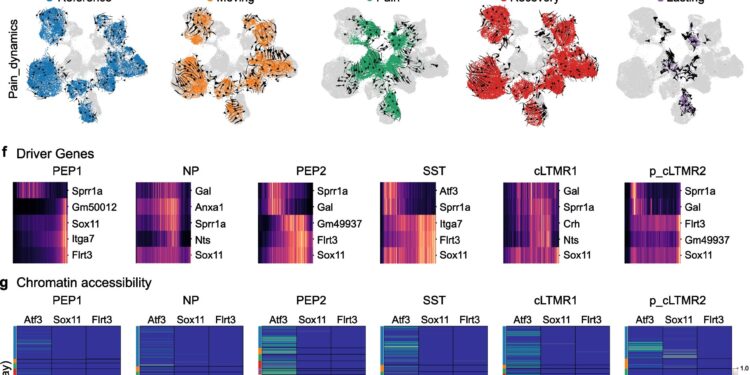Temporal molecular dynamics of nociceptors and pain states during neuropathic pain. Credit: Natural communications (2024). DOI: 10.1038/s41467-024-52052-8
Researchers at Karolinska Institutet have developed a new comprehensive map of genetic activity to understand the causes of chronic pain. The study, published in Natural communicationsopens the way to a more effective and non-addictive treatment of chronic pain and potentially headaches.
Researchers have long struggled to understand the complex mechanisms behind neuropathic pain after nerve injury, a global problem affecting millions of people. Current treatment often relies on opioids, which are associated with limited effectiveness and many side effects, including the risk of dependence.
Although new drugs are tested in clinical trials, they typically focus on a single pathway within a broader, complex pain phenotype.
Innovative Pain Atlas
The scientists behind the new study developed an innovative atlas of the somatosensory system during neuropathic pain called iPain, focusing on the dorsal root ganglia and trigeminal ganglia.
“Our atlas combines data from multiple sources and various models of chronic pain. This comprehensive approach allows us to analyze how the cells of the somatosensory system change throughout the development of chronic pain,” explains Saida Hadjab, principal investigator and head of the research group at the Department. of Neuroscience, Karolinska Institutet, who led the study.
Now available on CellxGene (iPain), this atlas provides valuable resources for future pain research.
“Using our atlas, we identified different phenotypic states of pain-related nociceptors (pain-sensing nerve cells) that are consistent across different pain models,” says Prach Techameena, Ph.D. student in neurobiology at the Hadjab Lab at KI.
The results led to the discovery of a specific condition that marks the persistence of pain in all chronic pain models analyzed.
Recovery from painful behavior
The team explored the therapeutic potential of targeting senescent cells in mice using established senolytic compounds and novel proteolysis-targeting chimeras (PROTACs).
“Administering the treatment one week after injury resulted in complete recovery from pain behaviors, with no adverse effects on anxiety, balance, motor function, or blood cells,” explain postdoctoral fellows Xiaona Feng and Kaiwen Zhang, respectively. and doctoral students. student in the Hadjab laboratory.
The research team hopes that these findings will benefit patients suffering from severe chronic pain, including trigeminal neuralgia and cluster headaches, for whom treatment options remain limited.
More information:
Prach Techameena et al, The iPain single-cell transcriptomic atlas identifies nociceptor senescence as a therapeutic target for the treatment of chronic pain, Natural communications (2024). DOI: 10.1038/s41467-024-52052-8
Provided by the Karolinska Institute
Quote: Comprehensive mapping of genetic activity brings hope to chronic pain patients (October 4, 2024) retrieved October 4, 2024 from
This document is subject to copyright. Except for fair use for private study or research purposes, no part may be reproduced without written permission. The content is provided for informational purposes only.



